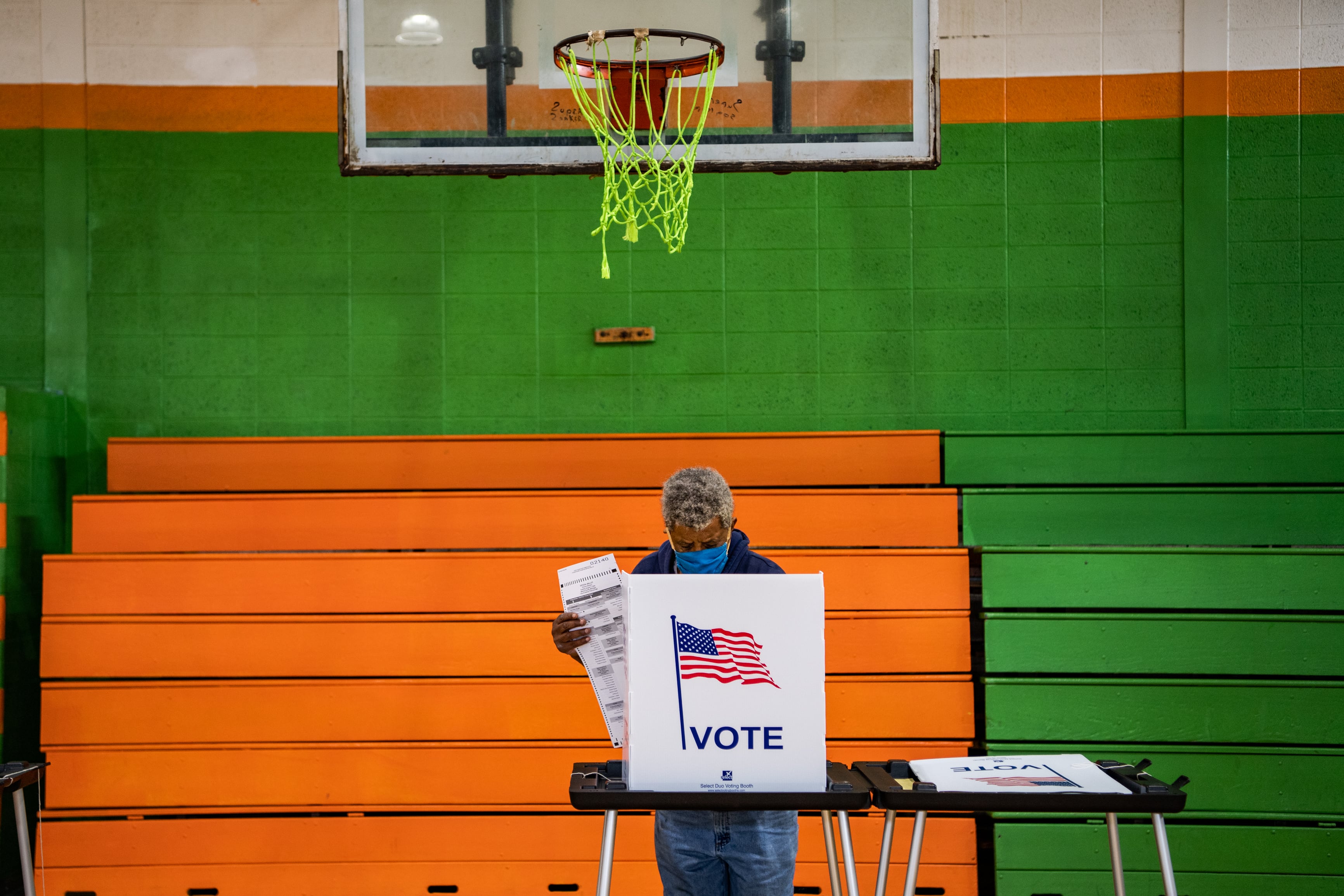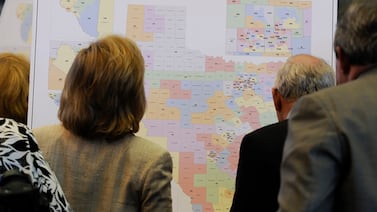As Michigan voters prepare to cast votes in the state’s primary next week, some local election clerks warn that navigating the design of the ballots remains a persistent problem for voters.
Michigan is one of a handful of states that prints Republican and Democratic candidates on the same ballot. But if voters select candidates across party lines, their ballot can’t be accepted.
“It is confusing,” said Katie Sims, the elections coordinator for Ottawa County, outside of Grand Rapids. “We consistently see voters look at the ballot … and look at it …,” she said, feigning bewilderment.
If a voter makes this mistake at a polling place, there are safeguards. The scanner that voters insert their ballots into spits the ballot back out, said Sims. The mistake can be quickly “cured” by giving the voter a new ballot and “spoiling,” or destroying, the old one so that only the new, correct one will be counted.
The confusion among Ottawa County voters has resulted in about 10-15% of ballots in August primaries being spoiled, compared with about 1-2% in general elections, said Sims. “Probably the highest percentage of [spoiled ballots] is during primary elections,” said Sims. Election officials in other jurisdictions say the combined ballot trips up their voters too.
Sims said her office sends out instructional advice to try to avoid the snafus.
But unlike in-person voters who can correct their mistake at the polls, absentee voters don’t get that opportunity once they put their ballot in the mail. Unless they realize their error after the fact and contact their local election office to replace their ballot, Michiganders who vote across party lines on their absentee ballots won’t have their votes counted.
State elections officials do not know the number of primary ballots that are rejected when voters select candidates across parties. But it could explain why absentee ballots are rejected at a higher rate during the primary than the general election. In Michigan’s 2020 primary, 0.66% of absentee ballots were rejected (10,600 out of 1.6 million cast), according to the secretary of state’s office. In the 2020 general election, only 0.46% of absentee ballots were rejected (15,300 out of 3.3 million cast).
Lansing City Clerk Chris Swope says voters need to “stay in their lane” when voting if they want their vote to be counted.
“If you vote for both a Democrat and Republican then the result of that is you voted for no one,” said Swope, who oversees elections administration for 85,000 registered voters in his district. “You pick your lane and you stay in it.”
Instructions on Michigan’s primary ballots read, “There may be multiple party sections on the ballot. Select the party section of your choice. YOU MAY VOTE IN ONE PARTY SECTION ONLY; YOU CANNOT ‘SPLIT YOUR TICKET.’ IF YOU VOTE IN MORE THAN ONE PARTY SECTION, YOUR PARTISAN BALLOT WILL BE REJECTED.”
Swope told Votebeat the state’s ballot “is something that’s always been an issue.” He added that having early in-person voting, which is among the proposed voting reforms the group Promote the Vote hopes will be put before voters on the November ballot, would allow voters to have their ballot scanned as early as two weeks before Election Day, possibly catching a faulty ballot with plenty of time left.
Michigan’s combined primary ballot has been around since at least 1954, but state lawmakers and elections officials know very little about its origins. The reason is to allow voters to keep their party selection private, unlike in many other states, where a voter chooses which party’s ballot to receive. That choice often is then recorded in a public voter file.
“While the current law protects voters’ privacy and independence by not requiring them to declare a party affiliation when registering or requesting their ballot, it also does enable voter confusion,” said Tracy Wimmer, the spokeswoman for Michigan Secretary of State Jocelyn Benson. “We consistently encourage lawmakers to be responsive to the concerns of Michigan’s clerks and collaborate with all of us to identify solutions that would protect voter privacy and accuracy while minimizing voter errors.”
The design of Michigan’s primary ballot presents a “conundrum,” says Whitney Quesenberry of the Center for Civic Design, which the U.S. Election Assistance Commission and local governments have consulted in designing ballots. Other states that combine their primaries on the same ballot include Wisconsin and Mississippi, she said.
Ballot design is so important to secrecy, Quesenberry said, but the secrecy can be potentially lost if an election worker has to be summoned for help with the ballot by the voter.
For Oakland County Clerk Lisa Brown, it’s clear the current primary ballot design needs to be updated. It’s a call Brown says she made in 2009 when she was a member of the Michigan House of Representatives.
Chris Thomas, Michigan’s longtime elections director until 2017, agreed the ballot does present an issue. He told Votebeat that he has had informal discussions with Michigan elections officials, former secretaries of state, and legislative staffers about the need to change the design of the ballots.
“It needs to be fine-tuned,” said Thomas. He suggests Michigan provide separate ballots representing the two major political parties.
“It takes a [knowledgeable] voter and someone to read the instructions and realize you have to pick one party, and if you cross over your vote won’t count,” said Thomas.
The current ballot design is also problematic because it may tempt voters who want to vote across party lines, even in a primary where the outcome is to winnow down the field of candidates for each political party.
“The main problem with this ballot is not confusion per se,” University of Michigan political scientist Michael Traugott said. “Voters may want to vote for a Democrat in one race and a Republican in another.”
Traugott acknowledges that those who vote by absentee ballot could become the real losers because they could realize too late that they voted across party lines.
“Then no ballot would be cast,” added Traugott.
For voting-rights activist Rebeka Islam, the ballot’s design is problematic because it could prompt confusion on how to cast a vote.
“It could potentially deter voters from showing up at the polls,” says Islam, president of the Detroit chapter of the League of Women Voters and activist for the Asian & Pacific Islander American Vote Michigan. “It can be especially confusing for voters whose first language is not English, since all ballots have been primarily printed in English,” she said
Longtime Wayne County voter Teresa Westbrook-Lienert told Votebeat that while she has not experienced any problems casting her vote, she can see how Michigan’s primary might present problems for others if they are new to voting.
“I have been voting since the late 1970s,” said Westbrook-Lienert. “I have voted in every election, except one.”
While Westbrook-Lienert wants to keep the current design of the ballot, she feels that all political parties should be represented but that the ballot should remain a straight ticket.
“Not being able to cross-vote will definitely be an issue for some,” said Westbrook-Lienert.
This article is made possible through a partnership with Bridge Michigan, Michigan’s largest nonpartisan, nonprofit news publication.
Oralandar Brand-Williams is a senior reporter for Votebeat in partnership with Bridge Michigan. Contact Oralandar at obrand-williams@votebeat.org.





